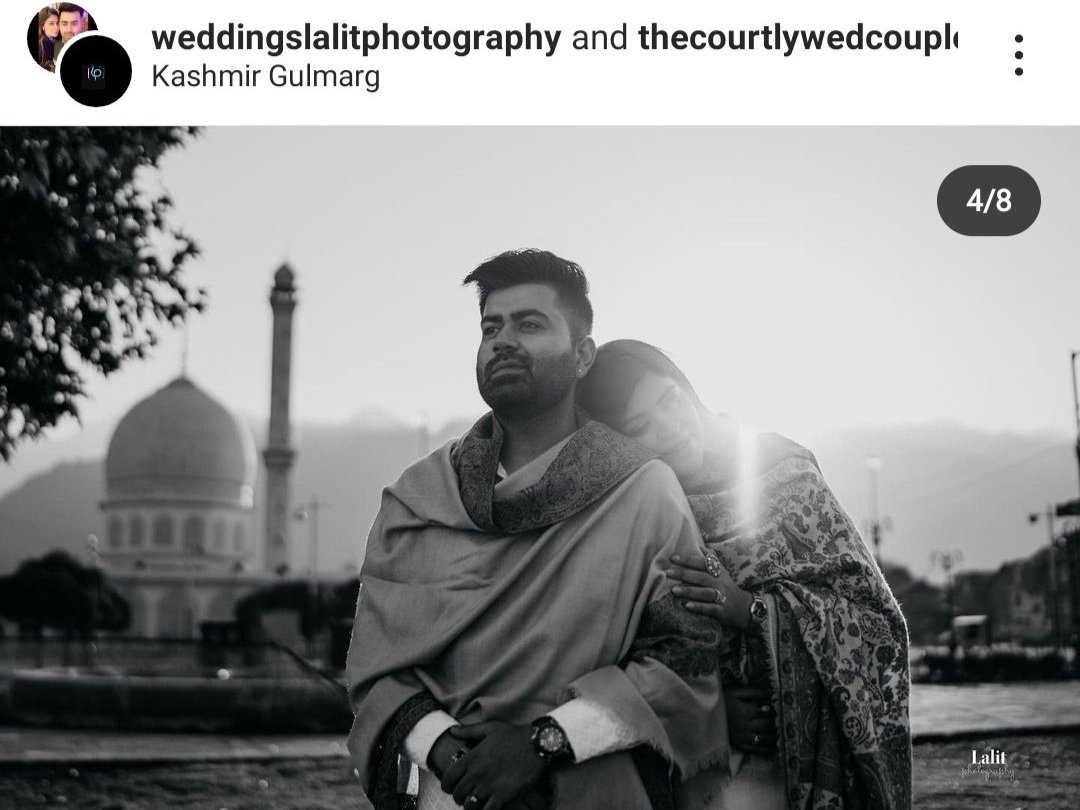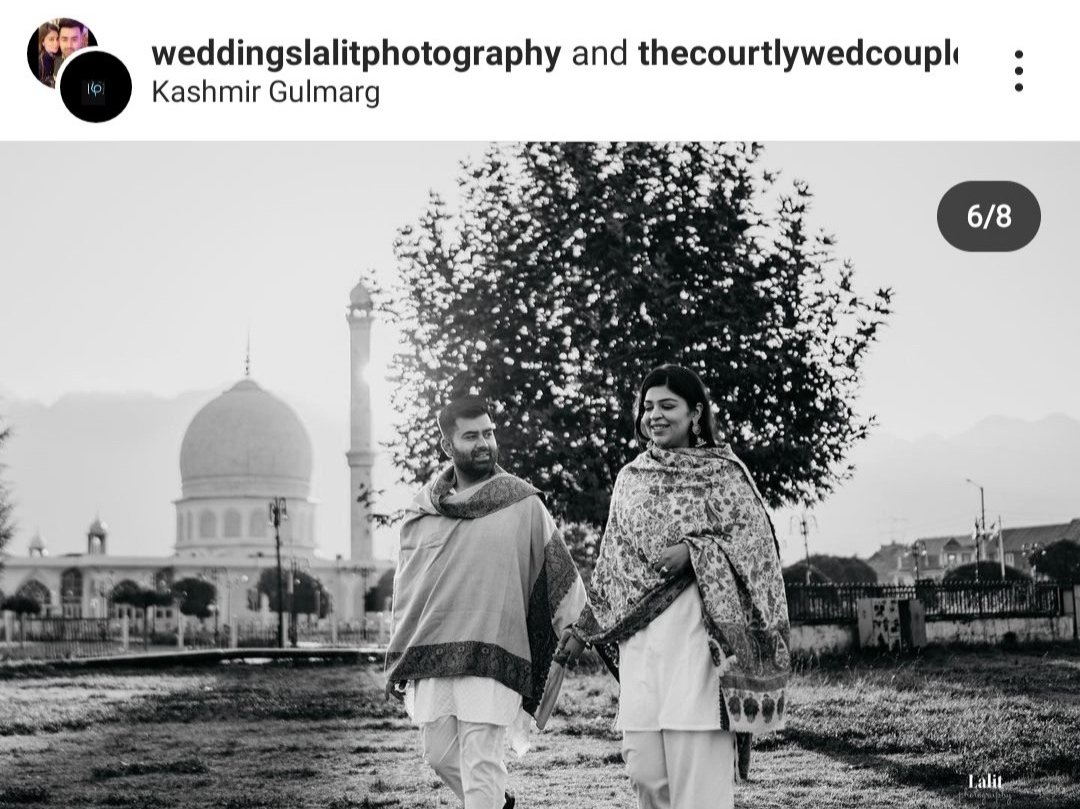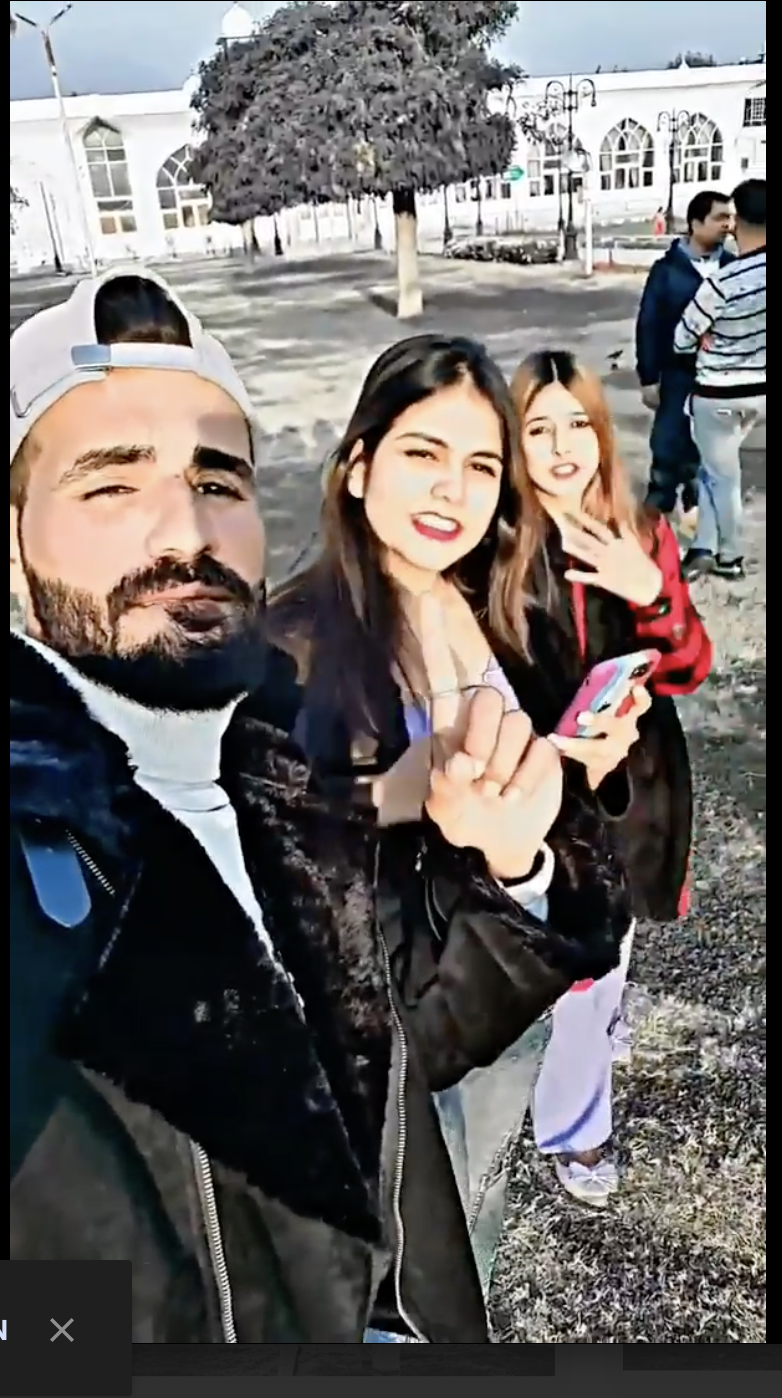Kashmiri Muslims Slam Social Media Influencers For Violating Faith And Sentiments
With the holy month of Ramadan currently underway, the Muslims in Kashmir flock shrines and mosques to devote their time into the remembrance of Allah (God). As the ban gains attention, the devotees can be seen walking past an official poster at Hazratbal shrine, restricting photo and videography without prior permission at the premises on Friday. Credits: Kaleem Geelani
SRINAGAR, Jammu-Kashmir — On 8 th October, last year, Canon India-the world’s top camera manufacturer brand, uploaded a picture from Kashmir on their social-media handles. As soon as it reached the audience in the Muslim-dominant region, a wave of anger and outrage swept across people after they saw a couple posing for a memorable picture in the backdrop of Hazratbal shrine, which is believed to be the most revered religious place in Kashmir.


Within hours, the big brand found itself in the line of fire as social media users back in picturesque valley called out the company openly for hurting their religious sentiments and legitimizing the actions by offering space on their online platforms, the follower base of which runs in millions.
As the social media spaces especially, Facebook stirred up with a flood of comments and widespread outrage, the locals asked for the immediate removal and apology from the company. However, playing down the backlash, the company later put down the post silently without any response.
Kashmir, is mired in an age-old conflict involving the long-standing tussle between two rival countries, India and Pakistan claiming their control in full over their region. Divided between two sides, governed by India and Pakistan, the majority region which falls on the Indian side has seen several political upheavals and unrests so far, resulting in prolonged communication bans and shutdowns.
As recently as in August 2019, when the New Delhi-led BJP government revoked Article 370 in Jammu and Kashmir- a special status and privilege given to the state by the Indian constitution, phone and internet communication were shut for months even as the high-speed 4G internet remained off the bounds for over one and a half year.
Amidst all the uncertainty, vlogging and other emerging genres of online content-making, come with a challenge for local social-media enthusiasts. Even though over the years, there has been a growing influence of social media fanfare among locals earning them huge followers and applause. But for a few of them driven by the ubiquitous temptation for fresh content, it has landed them into big trouble. “Samu Khan”, an Instagram influencer based in Kashmir, had a horrific experience in early December after she uploaded a video of her and two other friends behind a famous shrine in Kashmir. The video, posted on Instagram then, three friends were seen performing profane acts and gestures in front of the Hazratbal shrine, triggering widespread outrage and criticism from the locals.
Amidst all the uncertainty, vlogging and other emerging genres of online content-making, come with a challenge for local social-media enthusiasts. Even though over the years, there have been a growing influence of social media fanfare among locals earning them huge followers and applause. But for few ofthem driven by the ubiquitous temptation for fresh content, it has landed them into a big trouble.
“Samu Khan,” an Instagram influencer based in Kashmir, had a horrific experience in early December after she uploaded a video of her and two other friends behind a famous shrine of Kashmir. In the video, posted on Instagram then, three friends were seen performing profane acts and gestures in front of the Hazratbal shrine, triggering widespread outrage and criticism from the locals.
The controversial video spread like wildfire, with local people expressing their anger and disappointment over the actions and calling for a social boycott of such influencers in Kashmir. The video instantly became the talk of the town, as locals drew a reference to a series of events and called it an unfettered assault on the faith and sentiments of Muslims merely for cheap social media gains.
“For a minute, I was numb as I could not believe the extent of outrage the video had sparked. I stopped eating any food for two days and avoided my parents, as it had left too much damage,” Aamir Iqbal, an influencer who served a lead role in the controversial Instagram reel, told ReligionUnplugged.com.
Iqbal with his friends in the controversial video.
On that day, Iqbal, an aspiring 26-year-old man in a remote hamlet of Palmar in the mountainous Rajouri district of Jammu, traveled 250 kilometers (155 miles) to Kashmir to meet his two female influencer friends. Little did he know that this brief meet-up would become a nightmare for them.
“The massive outrage back in Kashmir spilled over to my locality at home, leaving me in huge distress and heartbreak,” Iqbal said. “As the local religious preacher mentioned my name in the mosque during the Friday sermon in reference to the viral video, I felt like my entire reputation was gone and there was no purpose to live this life anymore. That horrific episode will remain etched in my memory forever as the hardest and most shattering encounter of my life.”
Later, under pressure and anxiety, Iqbal asked his friend to remove the video from her account and issued a public apology through a video on social media. “This is what the situation necessitated, and at times, you’re just helpless before it,” he added. “Mistakes happen, even though I firmly believe in respecting the religious sentiments of my community, of which I’m a part.”
Historically rich in cultural and religious ethos, Muslims form the majority population, 68.31%, in Jammu-Kashmir, as per the 2011 official census. The Kashmir Valley, usually referred to as the abode of saints, carries the impressions of shrines and mosques across its entire landscape, the importance and sanctity of which come foremost for the hearts of believers.
In Kashmir, faith traverses beyond boundaries and is largely reflected in people’s overwhelming reverence for the shrines of saints, leaving their footprints across every nook and corner of the valley and attracting thousands of devotees to seek blessings. Any attempt to touch the faith of believers is fraught with backlash and criticism.
Like Khan, there have been many such videos from other influencers appearing on social media, either in indecent poses at religious places or making their intrusion into their internal affairs by livestreaming the pious practices that are held in high reverence and usually preferred to experience in a pious state of mind.
Some recent episodes of social media influencers using religious places for photo and video shoots have shaken the faith and belief of locals. The local community, comprising mostly Muslims, has been concerned and alarmed over the religiously sensitive content on the internet showing highly revered places in a romantic and musical light. This has triggered questions on the role of influencers, inviting calls for boycott and retribution against them.
The locals have questioned the entry and access of such influencers into religious places of Kashmir, saying that these places are sacred and no one should be allowed to venture into these pious places for photo opportunities in offensive postures and outfits, which go against the taste and veneration of them. In the past year, social media have been flooded with comments from locals as well as people from outside the region, as they show their disapproval for such videos aimed at demeaning and discrediting their places of worship.
Religious leaders have unequivocally condemned such kind of acts and calledupon all the Khateebs(preachers) to rake up the issue of the falling levels of decency and morality in society from the pulpits of mosques during sermons,which happen on Fridays every week.
“With the advancement in technology and its worrying influence on ground, our society is fast moving towards moral degradation. Some inappropriate videos of our revered places, appearing lately, are a testament to the fact that social-media craze has driven the youth-folk blind and forced them to cross limits and commit sins all for the sake of momentary likes and comments,” Nasir Ul Islam, the Grand Mufti (top religious jurist) of Kashmir, told The Religion Unplugged.
He said such repeated incidents of religious sacrilege come with a wake up for society at large, to stop all kinds of immoral activities and ensure the sanctity of religious places is maintained. “This will begin from homes, as parents have a major and vital role to play. They need to keep check of their children and make them answerable to the things they do and the time they spent on daily basis to prevent them from any wrongdoing, landing them into major trouble in the hereafter,” Islam added.
In the cultural context, Kashmir bears a conservative societal setup, wherein people especially women are bound by certain boundaries when it comes to matters of openness, freewill and self-reliance. But, with the growing influence of social media, few women are emerging out from the shackles of patriarchy to steer the path on their own.
The rising interest of locals towards social media content-making is fueled bythe improvement in Internet access in the troubled region in last three years,with very less or confined internet bans to specific areas. In Kashmir, there has been a norm of shutting down internet throughout entire area during encounters- the usual armed fight between militants and government forces, but now the ban has been almost lifted or restricted to the place of face-off, bringing much relief to the huge population affected by the frequent bans.
Even though the accessibility and influence have brought creative and talented people in the public limelight, but, it has equally exposed them to the harsh realities and acceptability levels of the local society. Taking the cue from competitors, most of the influencers now avoid filming at religious places for their social media content, fearing public onslaught and flak.
“We take due care and caution on certain issues of religion and culture, younever know how things can go wrong inadvertently. While upholding religious and cultural values, I always try to bring the best of content and entertainment to people as per their taste and acceptance. But we cannot be always flawless,” Musaib Bhat, a social media influencer turned producer and singer, told The Religion Unplugged.
However, as the calls and clamor for government action grew louder, the Jammu and Kashmir Wakf Board of finally intervened late last year with a ban on photo and videography across all religious places especially prominent shrines, coming under their ambit in Kashmir. The board, setup by government to regulate religious places in Kashmir, has a large number of shrines under their direct control to safeguard and manage their affairs.
Dr Darakshan Andrabi, chairperson of the board, tells The Religion Unplugged that the religious places were being turned into picnic spots and entertainment hubs to derive distasteful pleasures while hurting the sentiments and reverence of believers.
“These places are sacred and closer to the hearts of people, we are not going to allow any acts that are controversial in nature. We’re always there to ensure
the sanctity and reverence of our dargahs(shrines) stand protected at every cost,” Andrabi said. After receiving numerous written and verbal complaints, Andrabi added, the board had to take up the decision of banning photo-videography in shrines. However, with proper permission and clarity of purpose, officials of the board have been directed to decide on the use of camera in and around religious places.
Following the ban, prominent religious places of Kashmir now bear a signboard of “Photo and Videography Banned” on their entrances, which many see, as a much-needed step towards protecting the belief of devotees.
Religious leaders have unequivocally condemned such kind of acts and called upon all the Khateebs(preachers) to rake up the issue of the falling levels of decency and morality in society from the pulpits of mosques during sermons, which happen on Fridays every week.
“With the advancement in technology and its worrying influence on ground, our society is fast moving towards moral degradation. Some inappropriate videos of our revered places, appearing lately, are a testament to the fact that social-media craze has driven the youth-folk blind and forced them to cross limits and commit sins all for the sake of momentary likes and comments,” Nasir Ul Islam, the Grand Mufti (top religious jurist) of Kashmir, told TheReligion Unplugged.
He said such repeated incidents of religious sacrilege come with a wake up for society at large, to stop all kinds of immoral activities and ensure the sanctity of religious places is maintained. “This will begin from homes,as parents have a major and vital role to play. They need to keep check of their children and make them answerable to the things they do and the time they spent on daily basis to prevent them from any wrongdoing, landing them into major troublein the hereafter,” Islam added.
In the cultural context, Kashmir bears a conservative societal setup, wherein people especially women are bound by certain boundaries when it comes to matters of openness, freewill and self-reliance. But, with the growing influence of social media, few women are emerging out from the shackles of patriarchy to steer the path on their own.
The rising interest of locals towards social media content-making is fueled by the improvement in Internet access in the troubled region in last three years, with very less or confined internet bans to specific areas. In Kashmir, there has been a norm of shutting down internet throughout entire area during encounters- the usual armed fight between militants and government forces, but now the ban has been almost lifted or restricted to the place of face-off, bringing much relief to the huge population affected by the frequent bans.
Even though the accessibility and influence have brought creative and talented people in the public limelight, but, it has equally exposed them to the harsh realities and acceptability levels of the local society. Taking the cue from competitors, most of the influencers now avoid filming at religious places for their social media content, fearing public onslaught and flak. “We take due care and caution on certain issues of religion and culture, you never know how things can go wrong inadvertently. While upholding religious and cultural values, I always try to bring the best of content and entertainment to people as per their taste and acceptance. But we cannot be always flawless,” Musaib Bhat, a social media influencer turned producer and singer, told The Religion Unplugged.
However, as the calls and clamor for government action grew louder, the Jammu and Kashmir Wakf Board of finally intervened late last year with a ban on photo and videography across all religious places especially prominent shrines, coming under their ambit in Kashmir. The board, setup by government to regulate religious places in Kashmir, has a large number of shrines under their direct control to safeguard and manage their affairs.
Dr Darakshan Andrabi, chairperson of the board, tells The Religion Unplugged that the religious places were being turned into picnic spots and entertainment hubs to derive distasteful pleasures while hurting the sentiments and reverence of believers. “These places are sacred and closer to the hearts of people, we are not going to allow any acts that are controversial in nature. We’re always there to ensure the sanctity and reverence of our dargahs(shrines) stand protected at every cost,” Andrabi said. After receiving numerous written and verbal complaints, Andrabi added, the board had to take up the decision of banning photo-videography in shrines.
However, with proper permission and clarity of purpose, officials of the board have been directed to decide on the use of camera in and around religious places. Following the ban, prominent religious places of Kashmir now bear a signboard of “Photo and Videography Banned” on their entrances, which many see, as a much-needed step towards protecting the belief of devotees.
“This was the need of hour. For long we’ve been observing many hurtful videos on social media, now that the govt has cracked down upon it, this will satisf your conscience for now,” Arif Ahmad, an ardent believer of shrines, told The Religion Unplugged.Meanwhile, media-educators and experts in the region, stress upon the need to inculcate the sense of religious and cultural sensibilities among media enthusiasts, which they say, will prove helpful to prevent any major resentment within the society.
“Traditional messages and media forms followed certain guidelines and norms, which for sure are applicable to new media landscape, although now the audiences have turned into content creators so the responsibility has shifted as well,’’ Dr Monisa Qadiri, a Senior Assistant Professor of Journalism and Mass Communication at Islamic University of Science and Technology, told TheReligion Unplugged.If the sensitivities and sensibilities of the community are not considered with content overrunning them while trying to appear differently ‘cool’ or ‘vibing’ with rest of the world, Qadri says, it is bound to invite backlash. “Social media empowers a lot but a sense of responsibility remains a big clause,” she noted.
Kaleem Geelani is a freelance journalist based in Kashmir. His work has appeared in Nikkei Asia, The Quint, Gavi and others.


